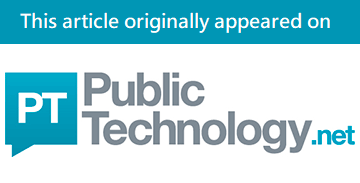Government’s new digital strategy chief has set out some of her top priorities, including ramping up delivery of cross-department missions dedicated to improving the use of data and supporting system reform.
Gina Gill recently joined the Cabinet Office’s Central Digital and Data Office as chief strategy officer, taking on a brief to provide strategic direction to the ongoing rollout of government’s digital and data roadmap – a three-year plan that runs until 2025. The roadmap is centred on six core missions, respectively covering: transformed services; the implementation of One Login; improved data usage; modernised tech infrastructure; digital skills; and a system that better supports transformation.
 Delivering a keynote presentation (pictured above) last week at the PublicTechnology Live conference in London, Gill – who joined CDDO from the Ministry of Justice, where she was chief digital and information officer – told attendees that she believes the use of data and systemic reform are the two missions where she would like to see an acceleration of progress in the coming months.
Delivering a keynote presentation (pictured above) last week at the PublicTechnology Live conference in London, Gill – who joined CDDO from the Ministry of Justice, where she was chief digital and information officer – told attendees that she believes the use of data and systemic reform are the two missions where she would like to see an acceleration of progress in the coming months.
While acknowledging that some progress has been made in data-sharing, some key barriers remain, including “legislative challenges, which we can look at – but also partly cultural challenges and [concerns about] who owns the data, and what is the risk of using it” – particularly to support the delivery of more proactive services, according to Gill.
“I think that we need to be giving people choice at the point that they’re using a service,” she said. “I think that is when people will choose to make their lives easier and say: ‘Yes, you can go and pull that data together to tell me whether I’m eligible for this thing, or how much tax I owe’… I think that we need to think differently about how we offer users choice at the point that they are receiving a service – and we do have some really good examples of that, in parts.”
The other of the roadmap’s key objectives where Gill would like to make advances in the coming months is the final mission, which aims to deliver “a system that unlocks digital transformation”.
The CDDO strategy chief said that progress in this regard will partly be concerned with growing the amount of senior leaders across departments that “understand, are interested in, and can talk about digital”. Ensuring that financing models and processes effectively support transformation is another key consideration, Gill said.
“There’s definitely more work to do on funding,” she told PublicTechnology Live. “I don’t think that we will ever be in a situation where we don’t have any legacy technology – but we should be in a situation where we are funding services – and therefore funding its ongoing maintenance and continuous improvement. Rather than [taking the approach of] ‘let’s make this big investment, and then let’s let it atrophy’.”
‘A different conversation’
Elsewhere, significant inroads have already been made, with Gill highlighting strong progress on the roadmap’s first two missions, dedicated to service transformation and the deployment of One Login.
CDDO has been working with departments on implementing a model of single service owners – named individuals to assume ultimate oversight for the delivery and performance of the service in question, across all applicable channels. Gill picked out the Home Office as a particular example of a department that has adopted and is seeing the benefits of this model, which is a “really, really important step” for the wider mission of improving services.
Such improvements are ultimately intended to ensure that, by next year, at least 50 of government’s 75 most critical or widely used services are rated as ‘great’ based on a set of common standards covering digital adoption, successful completion and user satisfaction metrics.
Gill said: “The services [mission] will leaves us with 50 great services, hopefully by the middle of next year – but what it will also leave us with is the start of a different conversation and a framework for how we actually start to properly measure and more of the services that we provide to the public and businesses.”
Work so far on delivering One Login – the new government-wide sign-in platform – was also picked out as a highlight by the CDDO strategy head.
“One Login… [provides] the ability for a user to be able to log in to multiple government services with one front-end – but it’s more than that, and it can be more than that,” she told delegates. “As well as being able to authenticate, there is a part of the service that also allows you to verify your identity and that, for me is really important; partly because of the number of times that I hear a friend say: ‘why can't I just log in once – why do I need to have this thing over here for tax, and this thing over here for something else, and this thing over here for something else again?’. So, it addresses a real need, and a real question that people have.”
Gill added: “But it also starts to put us on a different path in terms of a user of being able to see all of their interactions with government in one place. I think that’s really important that people can do that, as it starts us on the journey of putting users in control of their own data, and it gives us the beginnings of the ability to be able to, ultimately, provide more proactive services to our users – it gives us the building blocks to do that.”